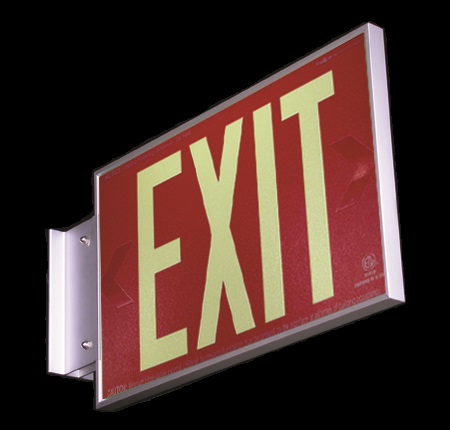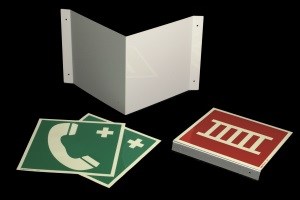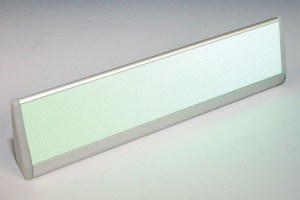Executive Summary
EverGlow is a manufacturer of ONLY (non-electrical) photoluminescent emergency lighting products. We believe that maximum life safety can best be achieved with the appropriate use of electrical and non-electrical emergency lighting.
- The following discussion is designed to provide accurate information, with references and links for additional research.
- EverGlow is NOT trying to confuse end users or resellers.
- We acknowledge that some manufacturers and suppliers on both sides of this discussion have made confusing and unsubstantiated claims about product performance and warranted or expected lifetime.
- As a manufacturer of efficient ENERGY STAR listed exit signs, EverGlow was very disappointed that this program was discontinued.
Contact EverGlow
Toll Free: (1) 866-744-4706
Telephone: (1) 704-841-2580
Email Us: This email address is being protected from spambots. You need JavaScript enabled to view it.
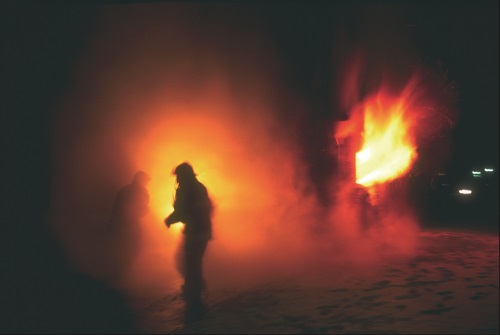
EverGlow Photoluminescent Signs & Markings help reduce the loss of life and property.
"During fire prevention inspections, hazards found included sprinkler systems out of date, improper installation of fire extinguishers or extinguishers obstructed, exit signs not illuminated, emergency lighting not functional, exit doors and aisles blocked and too many extension cords plugged into sockets."
-An Actual Inspection Report Summary
Improve Reliability & Effectiveness, Save Money
- EverGlow Photoluminescent Exit Signs contain no lamps, LEDs, electronics or batteries.
- Photoluminescent emergency lighting consumes ZERO energy; no electrical connection is necessary.
- EverGlow exit lights can be expected to last the life of your facility with NO failures.
- EverGlow exit signs have a 25 year limited warranty for interior installations.
- With no electrical source, EverGlow exit lights can be safely used in any hazardous environment.
- EverGlow exits are 100% aluminum and easy to recycle.
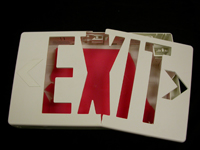
Electrical Exit Signs are made of plastic and are subject to damage & failure in commercial environments
"There is no electrical exit sign ever made that will continue to operate properly as long as a photoluminescent exit sign! And, this includes the new, longer lasting LED exit signs!"
-EverGlow
Increase Life Safety, Save Money
- EverGlow Photoluminescent Exit Signs provide 100% continuous operation with no chance for failure.
- EverGlow exit lights have no electrical components or batteries to fail every 4-7 years.
- EverGlow exit signs can be easily installed above the exit door or at floor level.
- Floor level exit signs have been shown to have significant advantages during evacuations where smoke is present.
- EverGlow aluminum exit lights do not melt or fail from the heat of a fire.
- EverGlow aluminum exits do not emit toxic gases that plastic signs, electronic components and batteries emit if heated during a fire emergency.
- There is never a chance of fire or environmental contamination from an EverGlow Photoluminescent Exit Sign.
"Inspection, Testing and Maintenance of electrical exit signs are simply not being done consistently. During a survey of (electrical exit signs in several) randomly selected hotels, 46 (27%) of the 169 fixtures tested for 30 seconds failed ..."
-An electrical exit sign manufacturer
Avoid High Maintenance & Replacement Costs for Electrical Exit Signs
An electrical exit sign is an electrical light fixture, an emergency luminaire, which may be less expensive to operate if it is replaced every 4-6 years. It has a power supply, circuit board, individual LEDs and a battery. How often do these components fail?
EverGlow aluminum photoluminescent exit signs are the only code approved, non-electrical, non-radioactive and non-toxic exit signs which are expected to last the life of your facility. And, each sign carries a 25 year limited warranty for interior installations!
How much more efficient would your facility maintenance department become if they could save hours every month inspecting EverGlow photoluminescent exit signs rather than inspecting, testing and repairing electrical LED exit signs?
- Replace the battery in an electrical sign every 2-4 years.
- Replace the electronics in an electrical sign every 4-6 years.
- Pay for maintenance labor and disposal costs for electrical exits
- EverGlow photoluminescent exit signs are easy to inspect monthly and test yearly.
- EverGlow exit lights can be expected to last the life of your facility with NO failures.
- EverGlow exit signs have a 25 year limited warranty for interior installations.
- Compare easy to maintain and long lasting EverGlow photoluminescent exit signs.
"Emergency lighting is the most neglected life safety component in most buildings. It was recently discovered that many emergency lighting systems are poorly maintained..."
-An electrical emergency lighting manufacturer
Why are Electrical Exit Signs not Maintained Properly?
- In this economic environment, the maintenance department is chronically short of resources.
- The cost of 3rd party inspection services continues to increase
- Code inspectors have the same problems - shortage of the resources necessary to do the job properly.
- Electrical exit signs do not normally operate in the emergency lighting mode.
- If not tested regularly as required by code, it could be years before a non-working sign is discovered.
- LED exit signs do not last forever without maintenance, the same as for all electrical light fixtures.
- The plastic enclosures on LED exit signs break when repairs are attempted; it is easier to replace the sign.
... Excluding healthcare and most government buildings, based on my experience I would estimate that more than 75% of the building owners/managers across the country are not testing their emergency lighting as mandated by the NFPA 101 Life Safety Code."
-A Code Consultant
What Danger does an Electrical Exit Sign Failure Present in Your Facility?
Interviews after emergency evacuations have shown that too many evacuees in real fire catastrophes fail to note the presence of electrical point sources of light. They could not see the electrical exit signs.
- Increased risk to life safety during an evacuation in the dark.
- Greater chance for injury or loss of life during and emergency evacuation.
- Potential fines, penalties, or facility closure if discovered by your fire code inspector.
- Potential penalty or higher premium from your insurance underwriter.
- Potential for litigation if you are shown to have ignored the requirement to maintain your emergency lighting.
- Contributes to the appearance of an overall lack of proper facility maintenance.
- Possible loss of leasing income or tenant(s).
- Possible loss of revenue for hotels, motels and other places of public accommodation.
"... Due to high costs associated with testing emergency lighting, facilities actually will forgo the tests. ..."
-A Manufacturer of Electrical Emergency Lighting, in an Advertisement for a Central Monitoring & Testing System
Protect Yourself & Your Staff from Failure of Electrical Exit Signs
Always inspect and maintain electrical exit signs as required by building or fire codes, NFPA 101 Life Safety Code, OSHA and the manufacturer.
The LED lighting market is a dynamic and confused landscape of quick start-up companies, importers and exaggerated claims about product performance. LED exit signs utilize monochromatic LEDs (generally red, green or blue) and generally avoid the color shift problems associated with white LEDs. However, monochromatic LEDs also suffer the same lumen degradation as do LED products. There are several reputable manufacturers of electrical exit signs; and they build a very good product. But, there are NO code or industry guidelines for how long LED exit signs can truly operate without dimming below the illumination required to safely evacuate people during an emergency. Electrical exit signs do not have an "expiration date" and are not tested by the manufacturer for visibility and legibility. LED exit signs are ONLY tested for illumination when they are listed to UL924. And, these signs will never again be as bright as they were when tested.
1. Realize that an electrical (LED) exit sign has a lifetime of only 5 - 10 years (some exit sign manufacturers more recently report that the sign will last only about five (5) years). Batteries in electrical exit signs last no more than 3 - 5 years. Mark the installation date on these electrical appliances just as you would any electrical fixture or luminaire that you expect to properly maintain. If you are not going to properly maintain these emergency lights, replace them on a regular schedule as you would relamp other lighting fixtures. Dispose or recycle old exit signs or exit lights as the manufacturer recommends or as required by your community. LED signs and lights are similar waste to that of old computers and laptops with batteries and circuit boards.
2. Where there is appropriate lighting, use EverGlow photoluminescent exit signs. Where smoke may accumulate above the door and obscure a single sign installed there, install a second exit sign at floor level on the latch side of the door.
3. Where electrical exit signs must be installed, use only LED exit signs from reliable manufacturers. Less expensive exit signs will fail sooner than advertised because they overdrive the LEDs, or do not provide adequate heat sinks for the LEDs. See product recall information below.
4. Inspect, Maintain and Test electrical exit signs each month as required by fire codes and recommended by the manufacturer. Test for 90 minutes at least every 12 months as required by fire codes and recommended by the manufacturer.
5. If LEDs, batteries, or other components of electrical exit signs fail between inspections, repair or replace as soon as possible. As with all electrical lighting products, exit signs are prone to failure at any time. As the building owner, you are required to maintain all emergency lighting in working order at all times.
"Electrical (LED) exit signs have a service life of 5-10 years; Radioluminescent (tritium) exit signs last for 10, 15 or 20 years; Photoluminescent exit signs have an unlimited service life and consume no energy."
-US Department of Energy
Consider the Recalls for Electrical Exit Signs & Emergency Lighting. CPSC
May 2016: Manufactured by Cooper Industries/Eaton.
Unknown quantity of fixtures recalled. These combo exit signs with emergency lights were made in October 2011 by Cooper/Eaton. They experienced a 50% failure rate where the emergency lights did not operate during testing. Apparently there was a failure in the circuit boards of these fixtures.
May 2014: Manufactured by Lithonia Lighting.
Approximately 1.7 million fixtures recalled. These emergency lights were sold in 2010 - 2014 by Lithonia Lighting, a division of Acuity Brands, and involve the Quantum ELM and ELM2 emergency lighting luminaires. The circuit boards overheated, fixtures melted or caught fire. These electrical emergency lights pose a fire hazard.
August 2011: Manufactured by Best Lighting Products.
Distributed by Lithonia Lighting, a division of Acuity Brands Lighting Inc. Approximately 450 electrical exit signs may fail to illuminate in the event of an electrical power failure. Manufactured in China.
August 2008: Manufactured by Cooper Lighting Inc.
Distributed under the brand names Sure-Lite and AtLite. Approximately 9,000 electrical exit signs and emergency lights could fail to stay illuminated in the event of an emergency and electrical power failure. This could result in a failure to provide adequate lighting to guide building occupants to an exit in an emergency. Manufactured in China.
May 2007: Manufactured by Cooper Lighting Inc.
Distributed under the brand names Contractor's Choice FasTest High Capacity Emergency Lighting Unit. Approximately 3,200 electrical emergency lights may fail to illuminate in an emergency and electrical power failure. A circuit board in the light could malfunction, preventing the lights from illuminating. This could result in a failure to provide adequate lighting to guide building occupants to an exit in the event of an emergency. Manufactured in China.
February 2003: Manufactured by Thomas & Betts Corp.
Distributed under brand names Emergi-Lite, Lightalarms and Dynaray. They were sold in 1997 - 1999. Approximately 31,000 electrical exit signs may overheat, fail when connected to 277 volt electrical systems and melt the enclosure. These electrical exit signs pose a fire hazard.
April 2001: Manufactured by Lithonia Lighting.
Distributed by Lithonia Lighting, a division of National Service Industries Inc. They were sold in 1992 - 1997. Approximately 1,200,000 electrical emergency lights have an internal electrical component that could overheat when connected to 277 volt electrical systems and melt the lighting enclosure. These electrical emergency lights pose a fire hazard.
July 2010: NEMA Comments on the CPSC Recall Database.
NEMA - The National Electrical Manufacturers Association (or The Association of Electrical and Medical Imaging Equipment Manufacturers) is the industry association to which the above manufacturers of electrical emergency lighting and exit signs belong. NEMA submitted comments to the CPSC prior to the creation of the recall database, www.SaferProducts.gov. NEMA members as a group are also concerned about counterfeit products - illegally produced, "look alike" products - which might cause a recall of their genuine products.
"LED luminaire reliability equals true LED Life. ... Because LED luminaires can dim well beyond useful light level, LED life must be performance based."
-US Department of Energy
Others Who Have Replaced or Supplemented Electrical Exit Signs with EverGlow Photoluminescent Exit Signs
Building owners and facility managers around the country. The inspector (e.g. fire code inspector or insurance inspector) just told us we must install exit signs over the front and back doors to our building. We have been in business for several years and these doors have never had exit signs and there is no electrical power near these doors suitable for use with emergency lighting or exit signs. Can EverGlow photoluminescent exit signs be used in these locations? EverGlow notes.
The real cost of owning a new LED exit sign is the initial installation, which requires an electrician, and the required maintenance. The maintenance cost is much lower for LED signs than for older electrical exit signs. But, the batteries still cost the same and the monthly inspections and yearly testing still cost the same as the older exit signs. And, they do not last as long as the manufacturer claims!
An EverGlow (code approved) photoluminescent exit sign is appropriate to use in your facility instead of an electrical exit sign if the inspector agrees. He is the AHJ - Authority Having Jurisdiction and he can pass or fail your proposed installation of our signs. To insure that he passes the installation of EverGlow signs, you must show him three (3) things:
1) You must have fluorescent lighting near the location of our exit signs.
2) You must have the minimum required 5 foot-candles of illumination on the sign face (this is very dim lighting and is approximately the same amount of light required to read a newspaper held at arm length).
3) You must show him that the light is unswitched and available 24 hours a day, 7 days a week. Or, the inspector must agree that it is sufficient and acceptable to have the lights on only when that part of the building is occupied.
How long do LED exit signs last? There are no reported studies of the actual lifetime for electrical LED exit signs. Some manufacturers claim up to 10 years; many building owners and facility engineers report an average lifetime closer to 5 years. Many electrical exit signs are replaced every 4-6 years rather than maintained - all batteries and many circuit boards or power supplies fail within that period of time. Plastic enclosures on the exit signs break when opened for servicing. EverGlow notes.
In 2001, the City of Portland replaced nearly all its red and green incandescent traffic signal lights with LED lamps ... The result was an annual energy and maintenance savings totaling $400,000 and net payback in less than three years. At the time, 13,300 signals were converted to LED (6,900 red signals and 6,400 green signals) at a total cost of $2.2 million. Approximate lamp life of the LEDs is 6 years .... The Consortium for Energy Efficiency (CEE) reports that LED traffic signals generally last 5 - 10 years. (LED exit signs use red and green LEDs.) The Responsible Purchasing Guide for LEDs, RPN.
In 1994, manufacturers of electrical exit signs with LED light sources reported up to 100 years for the expected lamp life. (There is no electrical exit sign, LED light source, battery or plastic enclosure that will last 100 years!) National Lighting Product Information Program, as tested by Rensselaer Polytechnic Institute, Lighting Research Center.
Link to this report.
Download this report as a pdf.
In 2005, manufacturers of electrical exit signs with LED light sources reported to ENERGY STAR up to 25 years for the expected life of the sign. ENERGY STAR required manufacturers of energy efficient exit signs (electrical and non-electrical) to provide at least a five (5) year warranty for all ENERGY STAR listed exit signs. (We are not aware of any electrical exit sign, LED light source, battery or plastic enclosure that will last 25 years.) ENERGY STAR - www.energystar.gov.
Link to this report.
Download this report as a pdf.
The following shall be considered when replacing old exit signs. There are two alternatives when considering an upgrade or replacement of an existing exit sign. In most cases, the most practical solution is to replace the entire exit sign with a new exit sign fixture. Some applications, however, are better suited for the installation of a retrofit kit rather than a completely new fixture. Relatively old signs (>5 years) are better candidates for replacement since other components including batteries and wires may be reaching the end of their warranty or useful life. The Responsible Purchasing Guide for LEDs, RPN.
While most utilities offer rebates to facilities that replace an existing incandescent or fluorescent exit sign with a new LED exit sign, electro-luminescent, or photoluminescent exit sign, fewer will pay for the installation of retrofit kits. And when they will pay for exit sign retrofits, they will often offer less than for full exit sign replacement. For example, Commonwealth Edison, a Chicago-based utility, will pay for the replacement or retrofitting of existing exit signs. Its policy is: Electroluminescent, photoluminescent, T1 cold cathode and light-emitting diode (LED) exit signs are eligible under this category. All new exit signs or retrofit exit signs must be UL924 listed, have a minimum lifetime of 10 years, and have an input wattage no more than 5 Watts per face (ComEd, 2009). Pacific Gas and Electric Company, located in the San Francisco Bay area, for example, offers businesses and government agencies $27 per fixture to replace incandescent-lit exit signs with LED models and $15 per fixture for replacing fluorescent-lit exit signs with LED models (PGE, 2009). The Responsible Purchasing Guide for LEDs, RPN.
How long do LEDs last? Unlike other light sources, LEDs usually don't "burn out". Instead, they get progressively dimmer over time (a process called lumen depreciation). LED useful life is typically based on the number of operating hours until the LED is emitting 70 percent of its initial light output. Good-quality white LEDs in well-designed fixtures are expected to have a useful life of 30,000 to 50,000 hours. The best linear fluorescent lamps can last more than 30,000 hours. A primary cause of lumen depreciation is heat generated at the LED junction. LEDs do not emit heat as infrared radiation like other light sources, so the heat must be removed from the device by conduction or convection. Thermal management is arguably the most important aspect of successful LED system design. Most manufacturers of high-power white LEDs estimate a lifetime of around 30,000 hours to the 70% lumen maintenance level. (The lifetime and efficacy of white LEDs is continually being studied because this is the primary light source for general purpose lighting that is expected to replace the fluorescent lighting commonly used in commercial buildings today; LED exit signs use red and green LEDs.) US Department of Energy.
New performance standards are being developed for LED light sources so that end users will have accurate descriptions of color (CRI), efficacy (Lumens of light output per watt of electricity consumed), lifetime and other measures of performance and light quality. These measures of performance will be unique to the LED lamp and the fixture (luminaire) in which it is installed. For exit signs and emergency lighting, LED lifetime will likely be measured by hours of operation to a lumen depreciation level of 70% of the original or design lumen output. But, manufacturers of these emergency luminaires may lobby successfully for a lifetime measure to only 50% of the design output. Either measurement must guarantee that all electrical exit signs perform as required by building and fire codes throughout the expected lifetime of the luminaire. There is currently no requirement for an "expiration date" on LED exit signs. EverGlow notes.
Reputable LED manufacturers report the L70 lifetime of monochromatic LEDs averages 50,000 hours (5 - 6 years, generally determined by their own laboratory, certified to recognized standards). Exit signs generally use red, green or blue monochromatic LEDs. To claim longer useful lifetimes than the LED light sources used in these exit signs, manufacturers of LED exit signs must build signs with very high initial luminance (much higher than that required by the performance standard UL924) to compensate for lumen depreciation over the expected life of the sign. Electrical exit signs are no longer code compliant if the luminance decays below the level specified by UL924.
Resources & Links to Learn More About LED Lighting Technology & Electrical Exit Signs
NEMA - National Electrical Manufacturers Association.
CEE - Consortium for Energy Efficiency - Energy Efficient Traffic Signals.
Electrical Contractor Magazine, October 2007 - LED Traffic Signals Get Green Light
DOE - Partnership with the Next Generation Lighting Alliance.
DOE - Next Generation Lighting Alliance - Lifetime of LED Luminaires.
Energy Efficient Exit Signs - September 2000.
Many advances and improvements have been made since this report was first written. At the time this report was published by Pacific Gas and Electric Company, LED exit signs had been on the market since 1985, but were too expensive for wide acceptance. Manufacturers frankly admitted that early generation LED signs suffered "premature decline in light output (severe lumen depreciation) and became visually ineffective after only a few years". At that time, there were 28 manufacturers of LED exit signs in the US. At least one of those manufacturers claimed that their LEDs would last more than 500 years, other manufacturers claimed their exit signs should last 50 - 100 years. Such claims caused the more conservative manufacturers to claim there were "different standards for end-of-life", "inaccuracies in advertising" and "absolute idiocy". One manufacturer claimed to know nothing about lumen depreciation in LEDs. Third generation LEDs and signs, and presumably signs more recently manufactured, do not dim so quickly. There is NO study which confirms that current production LEDs and exit signs do not suffer severe lumen depreciation after only 4-6 years. Photoluminescent exit signs were starting to become available to supplement or replace electrical exit signs at the time of this report.
Expanding the Market for Visually Effective, Highly Efficient Exit Signs - 1997.
This report, published by the Lighting Research Center, Rensselaer Polytechnic Institute, is one of the first to report on the early work to develop and market LED exit signs. Participants reported that 20% - 70% of the incandescent and fluorescent exit signs in buildings at that time would not function properly in an emergency. The promise in 1995 - 1997, as it is today, is that LED exit signs would last longer, require less maintenance and consume less energy than the older exit signs they would replace. At that time, LED exit signs cost several times more than exit signs using incandescent and fluorescent lamps. ENERGY STAR created new product performance requirements so exit signs could participate in this program. ENERGY STAR required that listed signs carry a warranty of at least 5 years from the manufacturer. This is also one of the few reports that state that there are "reports of incidents where loss of human life was attributed at least partially to failure or lack of exit signs, or poor directional information on exit signs".
US Department of Energy - Building energy Codes Program.
US Department of Energy - How Long will White LEDs Last?
This report, published in late 2009 by the DOE, states that the estimated useful life for high-power white LEDs is 30,000 - 50,000 hours (4 - 6 years). This is the time estimated for lumen depreciation to reach 70% of the original output (L70). DOE also footnotes that some manufacturers are claiming a useful life greater than 100,000 hours (10 years). Performance of LED lighting should improve over the next several years.
US Department of Energy - CALiPER Program - DOE Commercially Available LED Product Evaluation and Reporting Program
The DOE CALiPER Program is a non-commercial product evaluation program that seeks to compare the performance claims from various manufacturers with the actual performance of the LED luminaire. These are general purpose lighting products that will eventually replace fluorescent lighting systems commonly used in commercial facilities. There have been several rounds of testing and these results are available on this website. DOE states that inaccurate and incomplete claims for product performance, made by the manufacturers, are still "a concern".
RPN - Responsible Purchasing Network.
RPN - Responsible Purchasing Guide for LEDs (PDF)
US Consumer Product Safety Commission.
US Consumer Product Safety Commission - www.SaferProducts.gov.
www.Recalls.gov - Online Resource for Product Recalls in the US.
US Consumer Product Safety Commission - Recalls of Electrical Exit Signs in the US.
ENERGY STAR - Product Criteria for Exit Signs.
- 2003: An estimated 90% of all exit signs installed in the US are energy saving LED exit signs.
- Exit signs are no longer a part of the ENERGY STAR program, effective 1 May 2008.
- Required a minimum five (5) year product warranty from the exit sign manufacturer.
NEMA Premium Exit Sign Program.
The NEMA Premium Exit Sign Program provides the method for identifying efficient and effective models that are consistent with NEMA performance standards and tested in accordance with applicable UL and CSA Standards. Participating products eligible for the NEMA Premium Exit Sign Program are those which illuminate an integral legally required legend that meet NEMA's more stringent EM-1 Standard for Premium Exit Signs.
- Created by NEMA membership during 2008 - 2010.
- Does NOT have any requirement for minimum warranty period
- Does NOT have any requirement for defining the phrase, "expected lifetime", or similar references the useful and safe lifetime for listed LED exit signs.
- Maintains the ENERGY STAR requirement for maximum energy consumption.
NEMA - Anti Counterfeiting Issues.
The manufacturing and sale of counterfeit products is widely recognized by the United States and its trading partners as a crime involving the theft of intellectual property rights, including patents, trade, service and certification marks, and copyright. There are not only economic consequences from trafficking in counterfeit goods, including injury to the reputation of the rights-holder who has made a substantial investment in the quality of its product and brand name, but also to the deceived consumer, especially when health and safety is impacted, and governments that face a loss of tax revenue.
NEMA Commends CBP Vigilant Efforts on Preventing Counterfeit Electrical Goods
US Customs and Border Patrol - Fake Goods Real Dangers
FEMA - US Fire Administration - Hotel-Motel National Master List.
The federal government and national corporations inspect hotels and meeting facilities for the presence of and the maintenance of life safety systems on a regular basis. They then report their findings, and make their recommendations whether facilities are safe for employees to use. This is the approved list that the federal government uses.
Lithonia Lighting and Cooper Lighting are the largest manufacturers of emergency lighting and exit signs in the US. Thomas and Betts - Emergi-Lite - is the largest manufacturer in Canada. These companies advertise product warranties of 2-5 years for their LED exit signs. One company also offers a 7 year prorated warranty on batteries. One manufacturer claims the expected lifetime of the fixture is 10 years. To find the advertised warranty and the expected lifetime of LED signs, please visit these sites and, view the product description for several of their LED exit signs or use the site search feature to search for "warranty".
Lithonia Lighting - Exit and Emergency Lighting Products.
Cooper Lighting - Exit and Emergency Lighting Products.
Thomas and Betts (Emergi-Lite) - Exit and Emergency Lighting Products.

